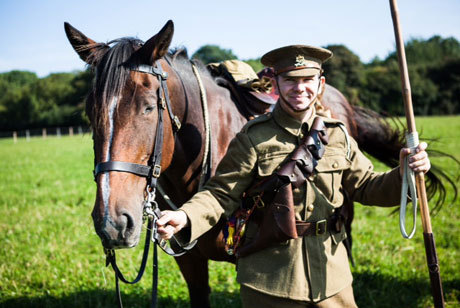You’ve probably come across ‘War Horse’ already. Published a little over 30 years ago as a children’s book by Michael Morpurgo, it was turned into a hugely successful piece for theatre – largely thanks to the jaw-dropping puppetry of the Handspring Puppet Company – and then picked up by Steven Spielberg who made it into a film. The story is slightly different in each case but the central idea – viewing the First World War (FWW) from the point of view of a horse – is constant to all three.

And if you haven’t already read it, marvelled at the stage production or seen it at the cinema, then I heartily recommend it.
But the thing I mostly wanted to draw your attention to in this blog is not so much the work itself, as something that rather cleverly complements it. It’s a series of events that will be taking place, organised by English Heritage as part of their FWW centenary programme, this spring and summer.
If you watched Downton Abbey on ITV during its FWW period you’ll recall that, in the story, the rather splendid building in which it is set was turned over for use as a convalescent hospital for much of the conflict. This, in fact, is what happened to many British country houses and castles at the time. While many of the occupants, above and below stairs, went off to fight, so their homes were requisitioned for any number of war-related uses: as training camps, signal stations or simply as places to provide temporary accommodation for troops awaiting deployment overseas.
A hundred years on and many of these same properties have passed into the care of English Heritage. This summer they’re going to be highlighting this war-time role by presenting the houses’ role on the Home Front, with particular reference to horses and the part they played in the conflict.
There’ll be a mixture of exhibitions, events and activities for children and, best of all, re-enactments to show the role of horses in different settings. People sometimes forget that they played an important part in the war. Clearly their value as an instrument of attack was highly limited in the face of machine guns and the sheer scale of the firepower that was deployed, but their speed, maneuverability and ability to get across the muddiest of terrains gave them the edge over the combustion engine for tasks like carrying messages and pulling ambulances.
I’ve also read that, for some, the simple fact of having a horse around went some way to keeping up morale. We see this today, of course, in the way that people – young and old – seem to instinctively want to stroke or pat a horse when they come across one.
‘War and the Horse’ events will take place at Wrest Park, a stately home converted into a convalescent hospital for troops; Dover Castle, a key strategic fortress that became a wartime lookout and battery; and Scarborough Castle, a site that was bombarded by German forces.
Check out the website for details of where and when.

Dover Castle photographed in 1920 (Aerofilms EPW000349)
 Department for Culture, Media and Sport
Department for Culture, Media and Sport